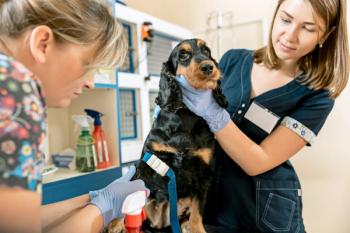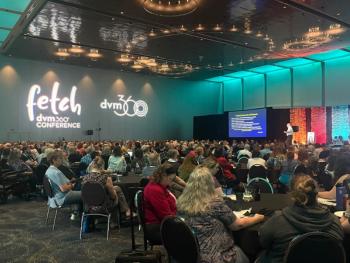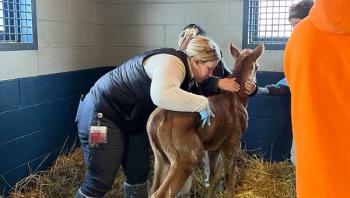
AVMA backs sow stalls, stresses welfare initiatives
Schaumburg, Ill. — The American Veterinary Medical Association (AVMA) votes to support sow gestation stalls until a more welfare-friendly housing system that's reliable, efficient and economically viable is conceived.
SCHAUMBURG, ILL. — The American Veterinary Medical Association (AVMA) votes to support sow gestation stalls until a more welfare-friendly housing system that's reliable, efficient and economically viable is conceived.
The long-awaited position praised by allied veterinary groups and condemned by animal activists lends two pages of scientific review to an assessment of sow stalls' relationship to animal welfare. The answer isn't clearcut, say authors of AVMA Task Force on the Housing of Pregnant Sows. Used properly, sow stalls can "minimize aggression and injury, reduce competition, allow individual feeding and assist in control of body condition." But they also restrict movement, exercise, foraging and social interaction, the position statement says.
"All systems have disadvantages for welfare." External variables make it impossible to determine overall welfare associated with stalls, and no one housing method is clearly better at meeting criteria of animal welfare, the statement says.
Standards for sow housing systems
Dividing issue
This overview stems from the task force's two-year review of more than 200 scientific documents. It replaces AVMA's former position on sow stalls as part of a 2003 directive by association delegates to take a "thorough and objective" look at the scientific evidence relating to the impact of gestation stalls on breeding sows.
While the new position is far from radical, the mere mention of sow stalls incites controversy with activists opposing the tight confines and industry experts touting the system's redeeming welfare values. According to AVMA, U.S. housing systems for pregnant sows are divided into two main types: group and individual, each with its own advantages and drawbacks.
"The AVMA recognizes that veterinarians approach the issue of pregnant sow housing from different viewpoints based on personal and societal values," the statement says. "Some veterinarians are opposed in principal to the close confinement of animals, some are opposed in principle to the use of animal for food and some work with the swine industry to maintain animal health and productivity."
The position statement
AVMA previously acknowledged sow stalls as being welfare acceptable, and according to the new report, not much other than an outline of welfare assessments has changed.
What the document makes clear is that task-force members reviewed sow gestation stalls as related to the physiology, behavior, production and health of the animals housed. A review of the literature studied provides the following welfare assessments:
- Physiology: Gestation stalls do not induce a physiologic stress response compared to group housing for pregnant sows.
- Behavior: Sows show different behavior when housed in gestation stalls compared to some group pens because of restricted movement, reduced caloric consumption and opportunities to forage, absence of bedding and restricted social interaction.
- Production: Sows kept in gestation stalls have production performance "not different" to sows kept in groups.
- Health: The rate of sow injury is reduced in gestation stalls compared to group housing. Industry experience indicates that other aspects of health are affected predominantly by factors other than the housing system.
Outside reaction
The statement fails to explain "different" behaviors exhibited by crated sow or clarify whether the terms "not different" production performance really means "identical." Nevertheless, Dr. Tom Burkgren is pleased. As executive director of the American Association of Swine Veterinarians, he praises the task force for using science to "remove the rhetoric and politics" associated with sow stalls.
"I think the report is consistent with what we've been saying to AVMA for years," he says. "They did an excellent job, really boiling it down to what we think is a very good position statement."
But animal activists including the Association of Veterinarians for Animal Rights (AVAR) are less enthused. AVAR spokeswoman Dr. Holly Cheever says the position statement is "blatantly counter to any notion of welfare."
"Basically it says all management systems have their problems, but with proper husbandry, crates are OK," she says. "In our opinion, there's no way the sow crate system can ever address welfare issues. This does not reflect well on the AVMA."
Inside review
Swine veterinarian Dr. Lisa Tokach disagrees. As a member of the task force that included animal activists, producers, veterinarians and plenty of varying viewpoints, she acknowledges "probably not one person on the committee is 100-percent satisfied."
The task force "scoured the literature," she says, considering every angle from veterinary medicine, animal welfare and epidemiology. What's she's discovered is that instead of focusing on a housing system, stakeholders should be honing in on management practices.
"Everyone is hung up on crates, and I don't think that's the critical question," she says. "I think we need to make sure the people entrusted with caring for these animals are doing a good job, and that makes the critical difference in terms of welfare. That's especially important considering right now, there's not one obvious system that's head and shoulders above the rest."
Newsletter
From exam room tips to practice management insights, get trusted veterinary news delivered straight to your inbox—subscribe to dvm360.




